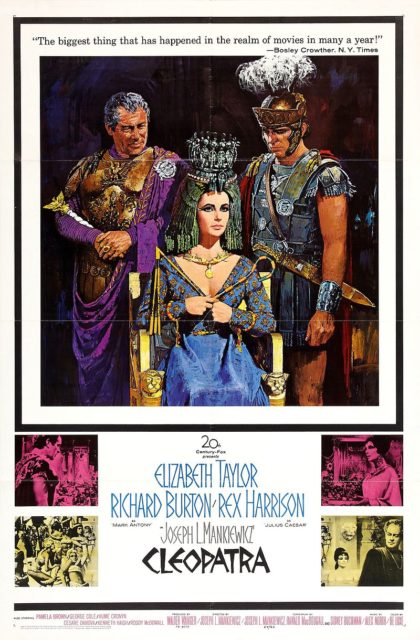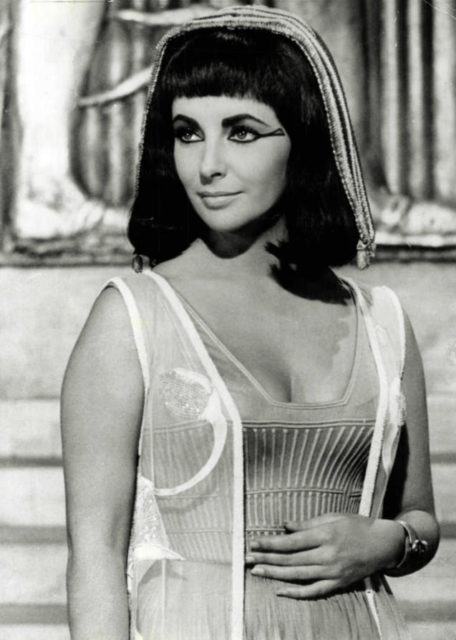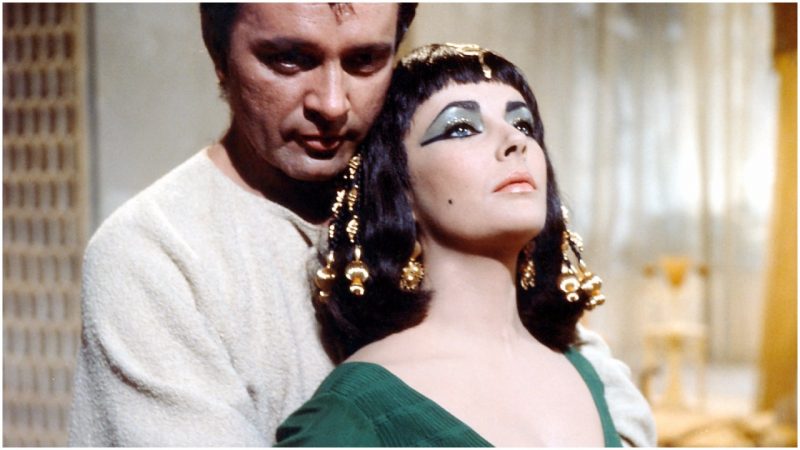When it was released in 1963, Cleopatra was a melodrama on screen and off: it was the most expensive movie ever made but also the year’s highest earner. Critics called the four-hour epic a snooze-fest, but it garnered nine Academy Award nominations—including Best Picture—and won four (albeit for design and cinematography, not for acting).
The making of the movie required nearly three years, four countries, and two separate casts including thousands of extras, all of which nearly bankrupted its studio, 20th Century Fox. It was also the first movie ever in which the scandalous love affair between its two magnetic superstars, Elizabeth Taylor and Richard Burton, both married to other people at the time, generated more heated headlines and lurid attention than anything that appeared on screen.
The making of the spectacularly sprawling movie was so famously tempestuous that at its star-studded gala premiere at the Rivoli Theater in New York City on June 12, 1963, when he was asked how he felt about the imminent screening, the beleaguered director Joseph L. Mankiewicz said, “I feel as though the guillotine were about to drop.”

Cleopatra, the story of the Egyptian queen’s ill-fated attempts to manipulate Julius Caesar and Marc Antony to save her empire, went into pre-production in England in 1959. Studio executives considered other famous actresses for the starring role, including Sophia Loren and Audrey Hepburn, before deciding on the green-eyed seductress Elizabeth Taylor, who was paid $1 million—an astounding sum at the time. (She would go on to make $7 million for the film from combined royalties.) Shooting began in London in 1960 and quickly fell apart: The soggy English weather was not representative of ancient Egypt, and Taylor contracted pneumonia, for which she was hospitalized. Three months of filming was tossed out, the original director Rouben Mamoulian quit, and Mankiewicz stepped in.
The Romance Of Antony And Cleopatra And The End Of The Pharaohs
The London sets were destroyed at a great cost and production moved to Rome in 1961 and later to Egypt. (The production wound up costing a record-breaking $44 million, or $349 million in 2017 dollars.) By then, Taylor, married at the time to her fourth husband, Eddie Fisher, was open about her affection for her co-star Richard Burton, who played Marc Antony. Burton himself was married to the Welsh actress Sybil Williams. Paparazzi pounced on the scandalous affair, and photos of the two lovebirds splashed across the front pages of tabloid newspapers and caused even the Vatican to weigh in with censure of her “erotic vagrancy.”
“It was probably the most chaotic time of my life,” Taylor told Vanity Fair in 2011. “What with le scandal, the Vatican banning me, people making threats on my life, falling madly in love … It was fun and it was dark—oceans of tears, but some good times too.”
Taylor and Burton divorced their spouses and got married on March 15, 1964. Their marriage was as melodramatic as their famous epic, providing fodder for the tabloids and gossip magazines. Though they both kept starring in films, their careers began to falter, as did their union: they divorced in 1974, only to remarry in 1976, and re-divorce nine months later.

The Taylor and Burton affair may seem tame by today’s standards, but the two ushered in an era when actors not only meet and marry on set, but their relationships become far more memorable than the films in which they star. In 1972, Ali MacGraw and Steve McQueen hooked up on the set of The Getaway and married a year later. They divorced in 1978, some saying she broke his heart. Warren Beatty, who fashioned himself as a modern Lothario, shocked the tabloids when he decided to settle down with Annette Bening, whom he had directed and co-starred in 1991’s Bugsy.
Remarkably, the two are still married. And of course, in the most famous example since Taylor and Burton, Brad Pitt fell in love with his co-star Angelina Jolie on the set of Mr. & Mrs. Smith in 2004, dumping his wife Jennifer Aniston for the screen siren and providing perhaps the most memorable mashup married moniker of all time—Brangelina.
